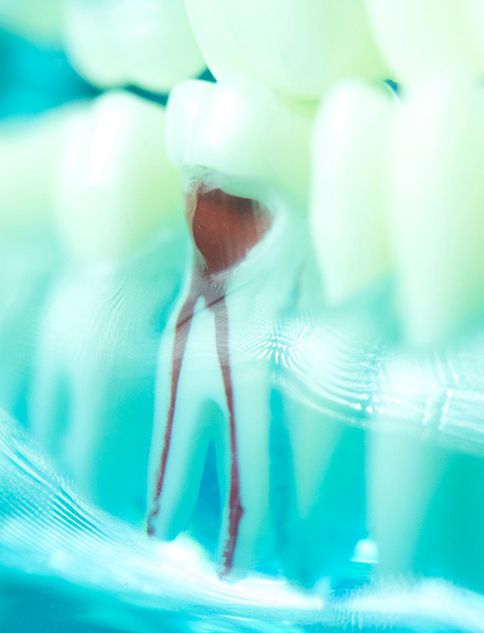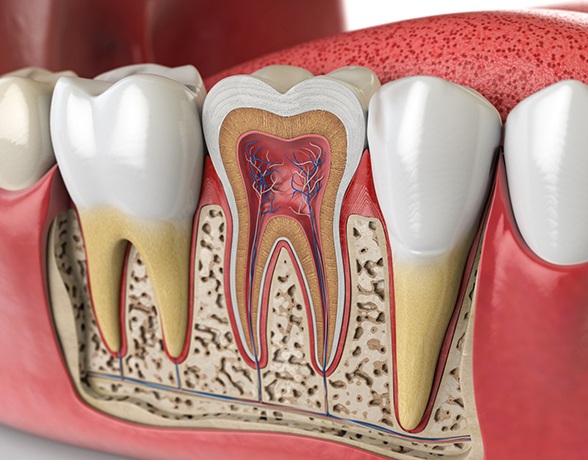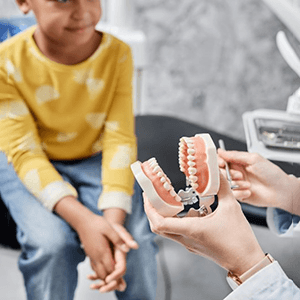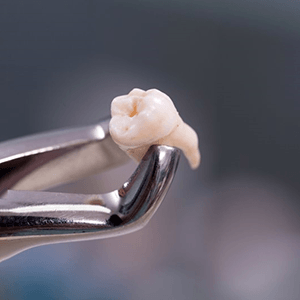
Root Canal Therapy – Grand Prairie, TX
Straightforward Treatment for Tooth Pain Relief

Is your loved one experiencing intense pain and discomfort in their pearly whites? One of the best ways to alleviate their condition is with root canal therapy in Grand Prairie. While this treatment doesn’t have a great reputation, it’s actually a virtually pain-free procedure that can effectively preserve damaged or decayed teeth! Not only will this avoid the need to replace your loved one’s pearly whites, but they’ll also get to keep their beautiful, comfortable, and natural smile for longer. Keep reading to learn more about root canal therapy or give our team a call to schedule a visit for your loved one.
Why Choose Disability Dental Services for Root Canal Therapy?
- Professional, Enthusiastic, & Friendly Dental Team
- Accepts Insurance & Offers Alternative Financing
- Provides Sedation Therapy For A Pleasant Experience
Does Your Loved One Need Root Canal Therapy?

If your loved one is experiencing a toothache, it doesn’t necessarily mean they’ll automatically require root canal therapy. Their condition may be due to other issues like an object stuck between their teeth or gum disease, which can be addressed with some other treatment. That said, if they’re struggling with a decayed, damaged, or infected tooth that can’t be fixed with a filling or crown, then a root canal may be essential. Here are a few symptoms you should look out for:
- New or worsening dental sensitivity to cold or hot temperatures
- Discomfort in one or several teeth when chewing
- Intense toothache that has lasted longer than a day
- A pimple-like bump on the gums by the affected tooth
- Inflamed, red, tender, or sore gums
The Root Canal Process

A root canal is designed to preserve natural teeth that have been damaged as well as alleviate pain. Before beginning your loved one’s procedure, our team will provide them with a local anesthetic to guarantee that they’re safe and comfortable throughout their appointment. Since their mouth will be completely numbed, they shouldn’t expect to feel discomfort during the treatment.
Our dentist will then make a tiny hole in the enamel so that they can access the inner layer of the tooth. They’ll remove all the infected tissue and damaged particles before cleaning and sanitizing the area. Once the tooth is disinfected, we’ll fill the hole with biocompatible dental material. Afterward, your loved one may need a dental crown placed over the treated tooth to strengthen and protect it.
The Benefits of Getting a Root Canal

Root canal therapy is one of the safest methods to save pearly whites and prevent dental issues in the future. Your loved one will be sure to enjoy various benefits from their procedure, including:
- Pain-free treatment – Not only can a root canal be performed in a single appointment, but it’s also completely painless! Most patients claim that it feels no worse than getting a regular filling, and the recovery time is much quicker compared to tooth extraction.
- Eliminate harmful bacteria – By reaching the inner pulp, we can clean out all harmful particles that can lead to pain and discomfort in your loved one’s smile.
- Preserve compromised teeth – Compared to removing a tooth, a root canal can save it as well as time, money, and future concerns.
Understanding the Cost of Root Canals

If your loved one’s dentist has recommended performing root canal therapy, it’s likely one of the most viable solutions for protecting their smile. However, you’ll want to know how much you’ll expect to pay for the procedure before committing to anything. During the initial consultation, we’ll go over the cost of root canals as well as your payment options to help make the treatment work within your budget. Until then, here’s what you should know before coming to visit us.
Factors That Can Affect Root Canal Cost

The price of your loved one’s root canal therapy can be impacted by a variety of factors. During their first visit, our team will need to consider the following components:
- The level of difficulty: The more complex and challenging the procedure, the higher the cost.
- The location of the tooth: The total price can vary based on the kind of tooth that needs to be treated. After all, molars typically consist of more roots to work with compared to front teeth.
- Additional services: If your loved one needs other treatments, such as a dental crown, this can raise the overall price of the procedure.
Is it Cheaper to Extract a Tooth?

Some people assume that it might be easier to simply forgo root canal therapy and remove the painful tooth altogether. However, while this might seem more cost-effective at first, you’ll need to consider the consequences of this decision. Once your loved one loses a tooth, their bite can become negatively affected if they don’t replace it. Not only will their jawbone begin to weaken and deteriorate, but their other nearby teeth can start to shift out of place to fill in the gap. To avoid these issues, you’ll need to help them get a tooth replacement like a dental bridge, which will typically need to be replaced every few years and can cost you more money in the long run. With a root canal, you can prevent all of that and allow your loved one to keep their beautiful, natural tooth instead.
Does Dental Insurance Cover Root Canal Therapy?

This dental service is typically considered a major procedure, so your dental insurance may be able to cover your loved one’s root canal therapy. This can be anywhere between 50% and 80% after meeting the deductible. Still, since every plan is unique, you’ll want to verify the details with your provider before starting anything. We can also help with this process if needed.
Other Options for Making Root Canal Therapy Affordable

If you don’t have insurance or your loved one isn’t included in your policy, you might still be eligible for alternative financing options. Our practice is partnered with CareCredit—a third-party financier that can help split the overall cost of dental services into monthly installments that come with little-to-no interest. This means you’ll be able to help your loved one get their root canal without emptying your wallet!